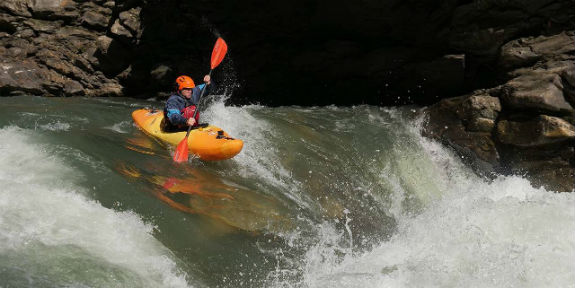On Jan. 15, PBS premiered Expedition With Steve Backshall, a 10-episode series that follows the British adventurer to far-flung locations, in search of natural wonders. It's beautiful and thrilling -- to the point of being downright scary.
Airing Wednesdays on PBS at 10 p.m. ET (check local listings for time and channel in your area), the series offers weekly episodes until Feb. 19, and then four more episodes in May.
The photography is stunning, and the travels of Backshall and his equally daring team seem less "manufactured" than some outdoor-adventure shows (although the show is clear there are camera and safety crews following them). In the first two episodes, the team rappelled down dizzying cliffs in Oman, and then kayaked through a treacherous, ice-filled fjord in Greenland.
In both cases (especially in the kayak episode, which includes a decidedly not-cuddly polar bear), it's clear that wrong moves could have disastrous or deadly consequences. In reality, Backshall broke his back and suffered other injuries in a 25-foot climbing fall in 2008.
In an episode called Bhutan -- White Water, airing Feb. 19, Backshall's kayak capsized while in rapids on a high-altitude mountain river.
At the recent TV Critics Association Press Tour in Pasadena, California, Backshall discussed his near-miss:
I was in that rapid for about four-and-a-half minutes. And the water itself is glacial meltwater. Not long ago, it was a glacier. It's incredibly cold. And it wasn't long into the experience that I realized that I couldn't get out of it myself, that I was running out of energy, that I was running out of any kind of ability to get back to the surface, and I was completely reliant on my crew to get me out of it. And if it hadn't been for Sal, my safety kayaker there getting back up against the rapids and getting that line to me, there is no way that I would be sitting here talking to you all here today.
...
I don't actually think I have had anything else in my life that's been as scary as that moment. I think the thing that sets it apart was how long it took. I had a near fatal rock‑climbing fall about 10 years ago, but it was all over in an instant. It happened in the blink of an eye. It was retrospective I realized how lucky I'd been this time around. Four and a half minutes is enough time to realize what's happening to you. It's enough time to process it, to think about the implications of what's happening to you. And that was a pretty traumatic experience.
What do we think of Expedition With Steve Backshall?
We give the show high marks for glorious cinematography and exposing viewers to amazing parts of the natural world. But, parents with adventurous children may want to sit and them down and also talk about the careful training and preparation the explorers go through, and the real risks that exploring and adventuring entail -- even if that's just in the house, the yard or the local area.
When he fell in 2008, Backshall was 35 and single. Now, he's married and the father of a toddler son and infant twins. This adds a new wrinkle.
Asked if anyone is cautioning him about the dangers he faces, Backshall said:
Yeah. My wife, quite a lot, actually. Weird as it may seem, the adrenaline side of this is almost incidental. The thing that drove the project on was the sense of genuine exploration that we had as a potential possibility in all the environments we were going to. And, actually, I would far rather have gotten through this series without nearly dying several times over. But inevitably, it's going to become a focus on moments like this, because those are those heart‑stopping moments. But I think people can see it's real. It's genuine. This is really what happened to us.
That's a good reminder that whatever happens to us seldom happens just to us.
Also, like just about every nature documentary on TV feels obliged to do these days, Backshall talks a lot about theories of human involvement in changes in the world's climate, and the effects of humans on wildlife habitats. Parents may also want to talk to children about their own ideas on these topics.
How Can You Watch?
Expedition With Steve Backshall can be seen (if you have cable) on PBS On Demand; episodes are also are available to stream on all station-branded PBS platforms, including PBS.org and the PBS Video App, available on iOS, Android, Roku, Apple TV, Amazon Fire TV and Chromecast.
PBS station members can few the first six episodes via Passport (contact your local PBS station for details). The series is also on DVD from PBS Distribution at shop.PBS.org, and for digital download.
The show is also available for a fee from Amazon Prime Video.
Here is the full airing schedule (all times Eastern, and as we said before, check your local listings):
Episode 1: Oman – Desert Canyon
Premieres Wednesday, January 15, 2020, 10:00–11:00 p.m. ET
World’s First: Descent into a new canyon system
Description: Follow Steve Backshall into an Arabian desert canyon that no human has ever explored.
Episode 2: Greenland – Frozen Frontier
Premieres Wednesday, January 22, 2020, 10:00–11:00 p.m. ET
World’s First: Kayak through the world’s largest fjord in ice break-up season
Description: Join Steve Backshall on his mission to explore the Arctic during its most volatile time of year.
Episode 3: Suriname – Lost World
Premieres Wednesday, January 29, 2020, 10:00–11:00 p.m. ET
World’s First: Expedition into the world’s last tract of pristine jungle
Description: Travel to the Guiana Shield, where Steve Backshall searches for new wildlife and natural wonders.
Episode 4: Mexico – Flooded Caves
Premieres Wednesday, February 5, 2020, 10:00–11:00 p.m. ET
World’s First: Dive into an unexplored flooded cave system
Description: Dive into a network of unexplored underwater caves in Mexico with Steve Backshall.
Episode 5: Borneo – Dark Shadow
Premieres Wednesday, February 12, 2020, 10:00–11:00 p.m. ET
World’s First:Exploration of an undiscovered sink hole, only recently spotted from a dark shadow on a satellite image.
Description: Follow Steve Backshall into a Bornean cave system that’s accessed by dropping down a sinkhole.
Episode 6: Bhutan – White Water
Premieres Wednesday, February 19, 2020, 10:00–11:00 p.m. ET
World’s First: White-water descent of a high-altitude mountain river
Description: Join Steve Backshall on his quest to kayak the last unrun river in Bhutan.
Episode 7: Greenland – Ice Mountain
Premieres Friday, May 8, 2020, 9:00-10:00 p.m. ET
World’s First: First ascent of an unclimbed summit in Greenland’s remotest peaks.
Description: Climb alongside Steve Backshall as he attempts to summit an unclimbed mountain in Greenland.
Episode 8: Mexico – Maya Underworld
Premieres Friday, May 15, 2020, 9:00-10:00 p.m. ET
World’s First: Exploration of a new dry cave to reveal how jaguars inhabit the caves of the Yucatan.
Description: Return to Mexico with Steve Backshall as he discovers Mayan secrets within subterranean caves.
Episode 9: Suriname – Ghost River
Premieres Friday, May 22, 2020, 9:00-10:00 p.m. ET
World’s First:First descent of an uncharted river.
Description: Ride along as Steve Backshall kayaks a Surinamese river that’s so remote, it doesn’t have a name.
Episode 10: Oman – Desert Fortress
Premieres Friday, May 29, 2020, 9:00-10:00 p.m. ET
World’s First:First ascent of an unclimbed desert rock face.
Description: Visit Oman’s Dhofar Mountains, where Steve Backshall encounters one of Earth’s rarest animals.
For more information on EXPEDITION WITH STEVE BACKSHALL, visit pbs.org. Viewers are also encouraged to engage in online conversation about the series by tagging @PBS and using #ExpeditionPBS on Facebook, Twitter and Instagram.
Photo: PBS
Kate O’Hare, a longtime entertainment journalist, is Social Media Manager and blog editor at Family Theater Productions.
Keep up with Family Theater Productions on our website, Facebook, Twitter and YouTube.



